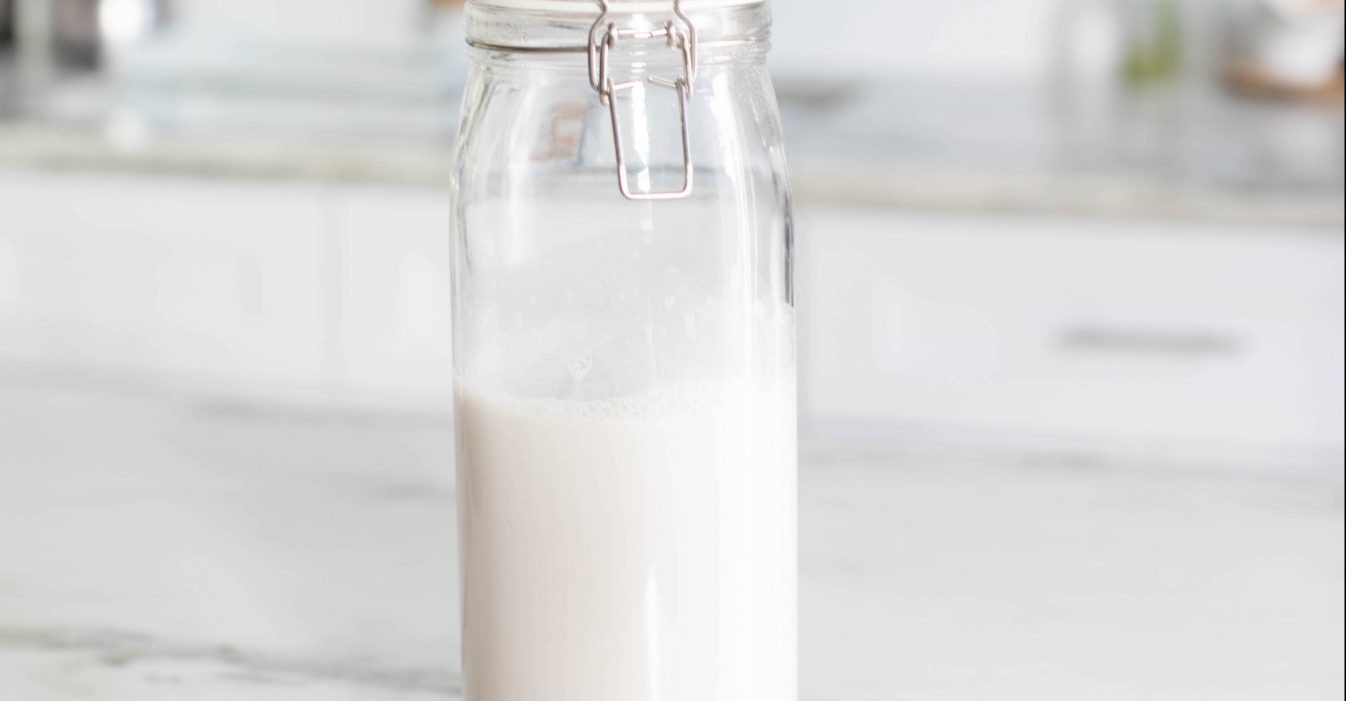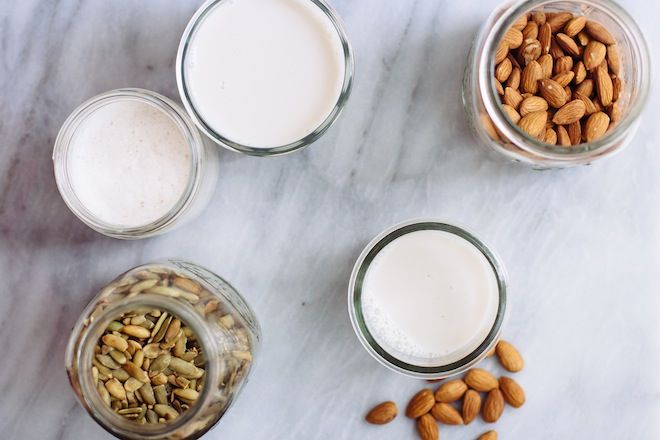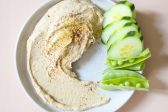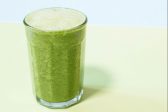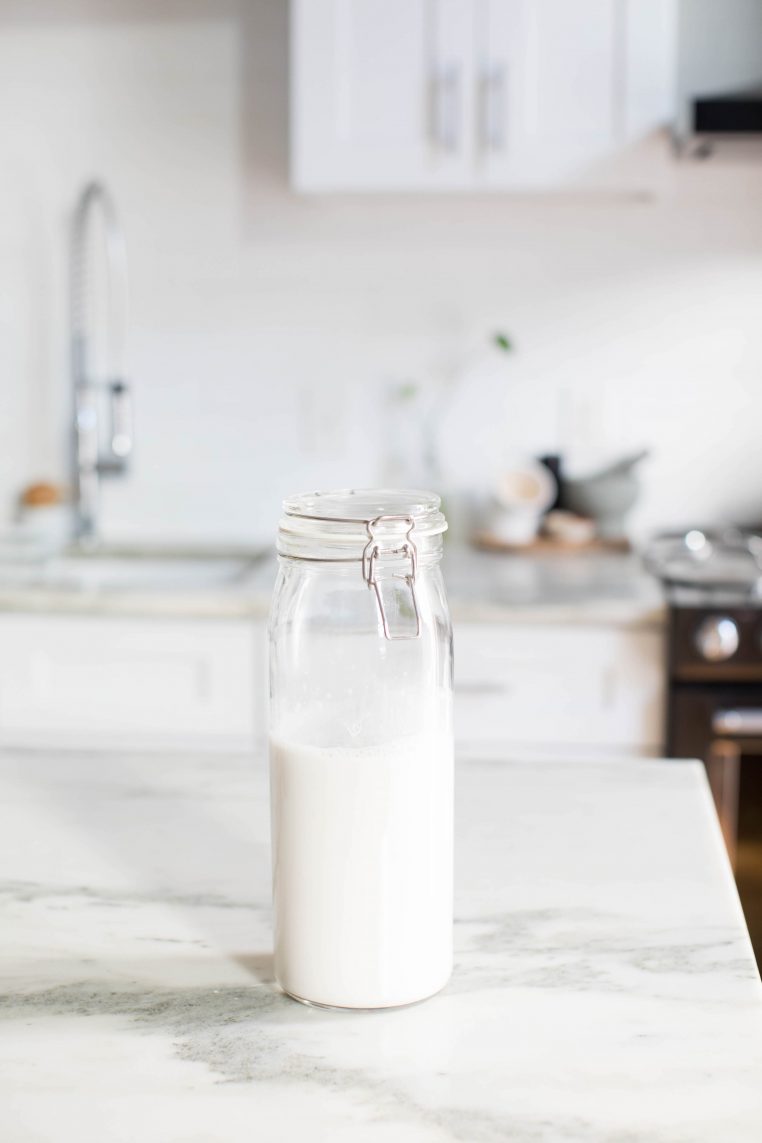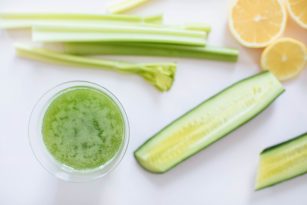Looking for a delicious alternative to cow’s milk? Enter the Nutrition Stripped guide on how to make nut and plant milk.
Learn how to make plant milk including homemade almond milk, hemp seed milk, and other nut milks. This article also shares the health benefits of making your own plant milk, and a couple of recipes to make with plant or nut milk!
Bookmark this Guide to Plant Milks for future use and feel free to share with friends and family who may be interested in going dairy free or who have a known dairy intolerance. This Guide to Plant and Nut Milk is also perfect for those of you who may suspect your body isn’t tolerating dairy well or simply looking for a delicious alternative to dairy milk.
What is Plant Milk?
Plant Milk is simply non-dairy “milk” made out of filtered water, nuts or seeds of your choice, and possible flavor additions. Examples are: 1) nut milk like almond milk, cashew milk, or macadamia milk, 2) seed milk like hemp milk, pumpkin seed milk, and flax milk and 3) non-nut and seed milk like pea milk made from split peas.
Whatever variety you choose, plant milk is a perfect way to still enjoy the versatility of cow’s milk without the dairy proteins and lactose involved. Most people are familiar with a lactose intolerance, but casein is a protein found in dairy that is also a common cause of inflammation and allergic reactions to dairy (1).
Nut milk is generally easier on digestion, taste great, are humane and environmentally sustainable, easy to make, affordable, and did I mention taste great? Yes, well they’re delicious!
Why would you choose non-dairy milk?
Well, dairy and I don’t get along. My body doesn’t like dairy and it doesn’t like me, we’ve established that now after several years of unpleasant signs and symptoms that my body wasn’t tolerating dairy.
I made my personal nutrition and lifestyle history a case study while I was in school and figured out dairy was one of the culprits keeping me from reaching optimal health (in hindsight, I, later on, I also figured gluten and I wasn’t friends either). I’ve been happily dairy free for about 7 years now and have never turned back because of the positive health benefits and complete absence of my symptoms I used to experience pre-dairy free.
Another reason why I’m not a fan of dairy is the production and mass factory farming of dairy cows and the way they’re treated and what they’re treated with. Unfortunately, the more common nature of the production of milk cows is that cows are often given loads of antibiotics to ward off diseases because of their unkempt living environments.
Should you avoid dairy?
Not everyone needs to stay away from dairy — some digest it just fine and their body feels good with it in their diet. Others may have a sensitivity to dairy, which is common and becoming more prevalent in the population.
Possible symptoms or signs that you may have a dairy intolerance, sensitivity, or allergy: constipation, gas, bloating, diarrhea, abdominal cramps, headaches or migraines, acne on the face/back/chest, sinus infections, severe allergies or nasal congestion, earaches (especially in small children), colic (in babies), runny nose, itchy eyes, hives, may worsen symptoms of IBS or celiac disease, heartburn, and arthritis/joint inflammation (2). These symptoms don’t necessarily arise immediately upon consuming dairy, but rather are symptoms of general consumption of dairy.
If you have any or most of these signs and symptoms to make a consultation with your trusted physician or with myself. Note, many physicians lack nutrition expertise, especially in the field of food allergies, as this isn’t a required fieldwork in their academic career. From personal experience and coaching my clients, you can not only thrive on a dairy-free diet but also enjoy it!
Disclaimer: just because I’m listing signs and symptoms of a dairy intolerance doesn’t mean that if you experience one or all of these symptoms you have a dairy allergy. It can be caused by many other possible reasons, which is why I suggest getting an in-depth consultation with me or with your physician to rule out any other suspected allergies or inflammation related issues (end disclaimer).
Dairy and Bloating
I often hear magazines giving their readers lists of foods for flat abs and stomachs. However, they fail to mention limiting or avoiding dairy. Some of these lists actually recommend dairy to decrease bloating, but this is simply not effective for those who have intolerances, allergies, or even small sensitivities.
Plant milk can be a digestive-friendly option that contains omega-3 fatty acids naturally found in the nuts and seeds which also help reduce inflammation.
Homemade Plant Mik
As I mentioned, making your own Plant Milk is so simple and affordable that you won’t need to buy it in the grocery store any longer. The price of non-dairy milk is actually one of the most common challenges I hear from my clients, i.e. “almond milk is expensive, I can’t buy that…”. However, plant milk can be extremely affordable if you buy nuts or seeds in bulk and make it at home in a blender.
Additionally, homemade plant milk is a better option since some of the ingredients used in very mainstream popular almond milk brands contain questionable ingredients, mainly carrageenan.
Carrageenan is a very common food additive made from red seaweed, it’s often used in organic/natural food brands since this is a “natural” food additive used to emulsify or thicken. Joanne Tobacman, MD has been a predominant physician-scientist in addressing how carrageenan should be taken out of our food systems due to the studies showing carrageenan may increase the risk of stomach ulcerations, glucose intolerance, and is cancer promotion (3, 4, 5, 6). Check out this great resource of how to avoid carrageenan in your foods (7).
The Calcium From Milk Myth
“Where will I get my calcium and vitamin D if I don’t drink my milk?” This is a routine question I get from so many clients that make me want to stomp in frustration. It’s not your fault at all – it’s the working of good marketing from the Dairy Council and traditions of drilling into our heads that milk is the only source of calcium and vitamin D in our diets.
Well, friends, this is wrong. Calcium is widely presented in many plant-based foods. For example, did you know 100 grams of broccoli raab contains about 100 mg of calcium? Even higher in calcium is the sesame seed. 1 cup of sesame seeds is equal to about 1400 mg of calcium and 100 grams almonds have about 380 mg of calcium.
As far as vitamin D goes, getting sunlight exposure outside daily for about 20-30 minutes (depending on your skin tone) during the day of highest sun will give you adequate amounts of vitamin D. Vitamin D supplements are also an alternative for those who should limit their exposure to sun or who don’t get enough sunlight during colder months or overcast seasons.
Different Types of Nut Milks
- Almond milk
- Cashew milk
- Pumpkin seed milk
- Flax milk
- Hazelnut milk
- Hemp milk
- Any other nut/seed you’d like to try!
Now that you’ve made your own nut milk (congratulations!), now you can save and reuse that beautiful fiber and protein-rich nut/seed pulp and make your very own nut flour for all of your gluten-free baking needs!
What To Do With Leftover Nuts from Nut Milk
After you’ve made your own plant milk and squeezed the pulp to make sure there is no more liquid, you can dehydrate the nut/seed pulp and make your own flour.
Here’s how to make nut or seed flour:
- On a dehydrator sheet (if you’re using a dehydrator) or cookie sheet (if you’re using an oven), spread the nut/seed pulp flat and even to cover.
- Dry: Dehydrator at 115 degrees F for 4 hours, conventional oven at 200 degrees F for 2 hours or until the mixture has become completely dry.
- Test if there is any moisture by pinching the flour, if the flour leaves moisture on your fingertips or creates a ball from pinching, it still needs to dehydrate more.
- Store in a glass jar, BPA free container, or another airtight container in the refrigerator for optimal freshness.
- Use in gluten-free baking and any recipes here on Nutrition Stripped that use almond flour, etc.
How to Use Your Homemade Plant Milk
Try your plant milk in these other Nutrition Stripped recipes:
- Pour it on top of Nourishing Muesli for a nutrient-packed breakfast
- Turn it into anti-inflammatory Turmeric Milk
- Make a delicious Warm Berry Bowl in the colder months
- Try it in a Matcha Tea Latte
Do you have a story you’d like to share about dairy and your lifestyle? Try this recipe and give it a go — share it on Instagram or submit your photo below to share how you make plant milk work in your lifestyle.
Resources
- https://www.ncbi.nlm.nih.gov/pmc/articles/PMC4586534/
- https://www.ncbi.nlm.nih.gov/pmc/articles/PMC4703621/
- https://www.cornucopia.org/DrTobacmanComment_toNOSB.pdf
- https://www.ncbi.nlm.nih.gov/pmc/articles/PMC1242073/pdf/ehp0109-000983.pdf
- https://www.ncbi.nlm.nih.gov/pubmed/22011715
- https://www.ncbi.nlm.nih.gov/pmc/articles/PMC1242073/
- https://www.cornucopia.org/shopping-guide-to-avoiding-organic-foods-with-carrageenan/

